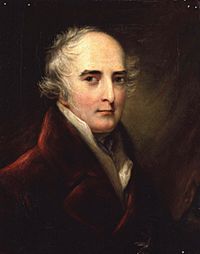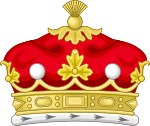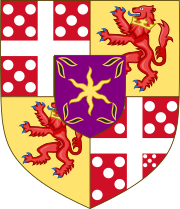Richard Wellesley, 1st Marquess Wellesley facts for kids
Quick facts for kids
The Most Honourable
The Marquess Wellesley
|
|
|---|---|
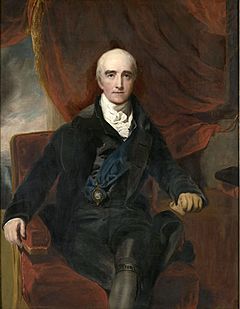
Portrait from the studio of Thomas Lawrence
|
|
| Lord Lieutenant of Ireland | |
| In office 8 December 1821 – 27 February 1828 |
|
| Monarch | George IV |
| Prime Minister | |
| Preceded by | The Earl Talbot |
| Succeeded by | The Marquess of Anglesey |
| In office 12 September 1833 – November 1834 |
|
| Monarch | William IV |
| Prime Minister | The Earl Grey |
| Preceded by | The Marquess of Anglesey |
| Succeeded by | The Earl of Haddington |
| Secretary of State for Foreign Affairs | |
| In office 6 December 1809 – 4 March 1812 |
|
| Monarch | George III |
| Prime Minister | Spencer Perceval |
| Preceded by | The Earl Bathurst |
| Succeeded by | Viscount Castlereagh |
| Governor-General of the Presidency of Fort William | |
| In office 18 May 1798 – 30 July 1805 |
|
| Monarch | George III |
| Prime Minister | |
| Preceded by | Sir Alured Clarke (provisional) |
| Succeeded by | The Marquess Cornwallis |
| Personal details | |
| Born | 20 June 1760 Dangan Castle, County Meath |
| Died | 26 September 1842 (aged 82) Knightsbridge, London |
| Resting place | Eton College Chapel |
| Nationality | British |
| Political party | Tory |
| Spouses |
|
| Parents |
|
| Alma mater | Christ Church, Oxford |
Richard Colley Wellesley, 1st Marquess Wellesley, KG, KP, PC, PC (Ire) (20 June 1760 – 26 September 1842) was an Anglo-Irish politician and colonial administrator. He was styled as Viscount Wellesley until 1781, when he succeeded his father as 2nd Earl of Mornington. In 1799, he was granted the Irish peerage title of Marquess Wellesley. He was also Lord Wellesley in the Peerage of Great Britain.
Richard Wellesley first made his name as fifth Governor-General of Bengal between 1798 and 1805. He later served as Foreign Secretary in the British Cabinet and as Lord Lieutenant of Ireland. In 1799, his forces invaded Mysore and defeated Tipu, the Sultan of Mysore, in a major battle. He also initiated the Second Anglo-Maratha War.
Wellesley was the eldest son of The 1st Earl of Mornington, an Irish peer, and Anne, the eldest daughter of The 1st Viscount Dungannon. His younger brother, Arthur, was Field Marshal The 1st Duke of Wellington.
Contents
Early life
Wellesley was born in 1760 in Dangan Castle in County Meath, Ireland, where his family was part of the Ascendancy, the old Anglo-Irish aristocracy. He was educated at the Royal School, Armagh, Harrow School and Eton College, where he distinguished himself as a classical scholar, and at Christ Church, Oxford. He is one of the few men known to have attended both Harrow and Eton.
In 1780, he entered the Irish House of Commons as the member for Trim until the following year when, at his father's death, he became 2nd Earl of Mornington, taking his seat in the Irish House of Lords. He was elected Grand Master of the Grand Lodge of Ireland in 1782, a post he held for the following year. Due to the extravagance of his father and grandfather, he found himself so indebted that he was ultimately forced to sell all the Irish estates. However, in 1781, he was appointed to the coveted position of Custos Rotulorum of Meath.
In 1784, he joined also the British House of Commons as member for the rotten borough of Bere Alston in Devon. Soon afterwards he was appointed a Lord of the Treasury by William Pitt the Younger.
.....
In 1793, he became a member of the Board of Control over Indian affairs; and, although he was best known for his speeches in defence of Pitt's foreign policy, he was gaining the acquaintance with Oriental affairs which made his rule over India so effective from the moment when, in 1797, he accepted the office of Governor-General of India.
India
Voyage
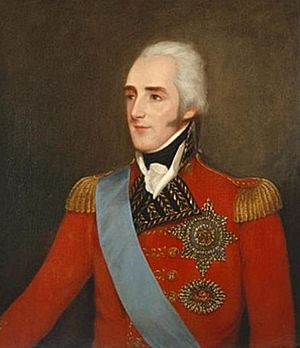
Mornington seems to have caught Pitt's large political spirit in the period 1798 to 1805. That both had consciously formed the design of expanding their influence in the Indian subcontinent to compensate for the loss of the American colonies is not proven; but the rivalry with France, which in Europe placed Britain at the head of coalition after coalition against the French, made Mornington aware of the necessity of ensuring French power did not reign supreme in India.
Governor-General
War with Mysore
On the voyage out, he formed the design of curbing French influence in the Deccan. Soon after his arrival, in April 1798, he learned that an alliance was being negotiated between Tipu Sultan and France. He was soon after was appointed Governor-General of India on May 12, replacing the Lord Cornwallis. Mornington resolved to anticipate the action of the Sultan and ordered preparations for war. The first step was to order the disbandment of the French troops entertained by the Nizam of Hyderabad.
The capture of Mysore followed in February 1799, and the campaign was brought to a swift conclusion by the capture of Seringapatam on 4 May 1799 and the death of Tipu Sultan, who was killed in action. In 1803, the restoration of the Peshwa proved the prelude to the war against Sindhia and the raja of Berar, in which his brother Arthur took a leading role.
The result of these wars and of the treaties which followed them was that French influence in India was reduced to Pondicherry, and that Britain acquired increased influence in the heartlands of central India. He proved to be a skilled administrator, and picked two of his talented brothers for his staff: Arthur was his military adviser, and Henry was his personal secretary. He founded Fort William College, a training centre intended for those who would be involved in governing India. In connection with this college, he established the governor-general's office, to which civilians who had shown talent at the college were transferred, in order that they might learn something of the highest statesmanship in the immediate service of their chief. He endeavoured to remove some of the restrictions on the trade between Europe and Asia. He took the time to publish an appreciation of British composer Harriet Wainwright's opera Comala in the Calcutta Post on 27 April 1804.
Policies
Both the commercial policy of Wellesley and his educational projects brought him into hostility with the court of directors, and he more than once tendered his resignation, which, however, public necessities led him to postpone till the autumn of 1805. He reached England just in time to see Pitt before his death.
He had been created a Peer of Great Britain in 1797 as Baron Wellesley, and in 1799 became Marquess Wellesley in the Peerage of Ireland. He formed an enormous collection of over 2,500 painted miniatures in the Company style of Indian natural history.
He founded short-lived 'The Institution for Promoting the Natural History ' in 1801 at Barrackpore near Calcutta. The institution was supervised by Francis Buchanan-Hamilton.As a part of this endeavor 'Barrackpore Menagerie' was founded which survived till 1878 when animals and birds were transferred to Alipore which later became Calcutta Zoo.
A motion by James Paull (MP) to impeach Wellesley due to his expulsion of British traders from Oudh was defeated in the House of Commons by 182 votes to 31 in 1808. Mornington also disapproved of liaisons between Company officials and soldiers and locals, seeing them as improper.
Britain
Re-entering Parliament
After his governorship ended in 1808, he returned to Britain and begun to join British politics yet again. The few years back in Parliament was quite uneventful, despite the overwhelming crisis the British government has faced with the war in Europe and the domination of Europe by Napoleon Bonaparte. The growing French influence threatened Britain and it’s empire to the extent of high tensions in the country. While the crisis abroad wasn’t enough, the British government has been led by weak and unsuited men during from 1806-1809 with two short-lived ministries under Lord Grenville and the Duke of Portland respectively.
But when on the fall of the coalition ministry in 1807, Wellesley was invited by George III to join the Duke of Portland's cabinet, but he declined, pending the discussion in parliament of certain charges brought against him in respect of his tenure as governor-general and criticism of his administration. Resolutions condemning him for the abuse of power were moved in both the Lords and Commons but defeated by large majorities.
Ambassador to Spain
In 1809, Wellesley was soon appointed as the British ambassador to Spain by Perceval. He landed at Cádiz just after the Allies victory at the Battle of Talavera, and he tried to bring the exiled Spanish government into an effective co-operative agreement to support the campaign against the French in country with his brother, Duke of Wellington who was commander-in-chief of the British Forces, through the failure of his allies failed to cooperate with the Spanish unsuccessfully. Soon the British and Spanish forces had been forced to retreat into Portugal after French counter-attacks.
Foreign Secretary
A few months later, after a dispute between George Canning and Robert Stewart, Viscount Castlereagh led to a duel and soon led to the resignation of both ministers, Perceval offered a new position in the cabinet and Wellesley accepted the post of Foreign Secretary in Spencer Perceval's cabinet. Unlike his brother Arthur, he was an eloquent speaker, but was subject to inexplicable "black-outs" when he was apparently unaware of his surroundings.
He held this office until February 1812, when he retired, partly from dissatisfaction at the inadequate support given to Wellington by the ministry, but also because he had become convinced that the question of Catholic emancipation could no longer be kept in the background. From early life, Wellesley had, like his brother Arthur, been an advocate of Catholic emancipation, and with the claim of the Irish Catholics to justice, he henceforward identified himself.
Twice Viceroy of Ireland, and one of the original Knights of St Patrick, he surrendered that order on being made a Knight of the Garter on 31 March 1812.
Upon Perceval's assassination he, along with Canning, refused to join Lord Liverpool's administration, and he remained out of office until 1821, criticising with severity the proceedings of the Congress of Vienna and the European settlement of 1814, which, while it reduced France to its ancient limits, left to the other great powers the territory that they had acquired by the Partitions of Poland and the destruction of the Republic of Venice.
He was one of the peers who signed the protest against the enactment of the Corn Laws in 1815. His reputation never fully recovered from a fiasco in 1812 when he was expected to make a crucial speech denouncing the new Government, but suffered one of his notorious "black-outs" and sat motionless in his place.
Family life
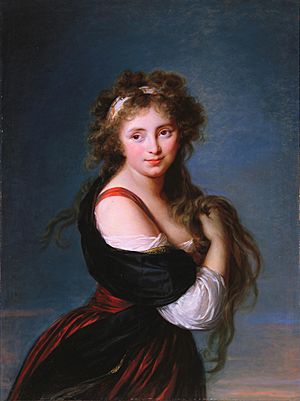
Wellesley lived together for many years with Hyacinthe-Gabrielle Roland, an actress at the Palais Royal. She had three sons and two daughters with Wellesley before he married her on 29 November 1794. He moved her to London, where Hyacinthe was generally miserable, as she never learned English and she was scorned by high society: Lady Caroline Lamb was warned by her mother-in-law, Elizabeth Milbanke, a noted judge of what was socially acceptable, that no respectable woman could afford to be seen in Hyacinthe's company.
Their children were:
- Richard Wellesley (1787–1831), a member of parliament
- Anne Wellesley (1788–1875), who married firstly Sir William Abdy, 7th Baronet, and secondly Lieutenant-Colonel Lord Charles Bentinck. She and her second husband are ancestors of King Charles III)
- Hyacinthe Mary Wellesley (1789–1849), who married Edward Littleton, 1st Baron Hatherton
- Gerald Wellesley (1792–1833), who served as the East India Company's resident at Indore.
- The Rev. Henry Wellesley (1794–1866), Principal of New Inn Hall, Oxford.
Through his eldest daughter Lady Charles Bentinck, Wellesley was a great-great-great-grandfather to Queen Elizabeth II.
Wellesley also had at least two other illegitimate sons by his teenage mistress, Elizabeth Johnston, including Edward (later his father's secretary), born in Middlesex (1796-1877). Wellesley's children were seen by Richard's other relatives, including his brother Arthur, as greedy, unattractive and cunning, and as exercising an unhealthy influence over their father; in the family circle they were nicknamed "The Parasites".
Following his first wife's death in 1816, he married, on 29 October 1825, the widowed Marianne (Caton) Patterson (died 1853), whose mother Mary was the daughter of Charles Carroll of Carrollton, the last surviving signatory of the United States Declaration of Independence; her former sister-in-law was Elizabeth Patterson Bonaparte. Wellington, who was very fond of Marianne (rumour had it that they were lovers) and was then on rather bad terms with his brother, pleaded with her not to marry him, warning her in particular that "The Parasites", (Richard's children by Hyacinthe) would see her as an enemy. The Duke's concern seems to have been misplaced; they had no children, but the marriage was a relatively happy one - "much of the calm and sunshine of his old age can be attributed to Marianne".
Later life
Lord Lieutenant of Ireland
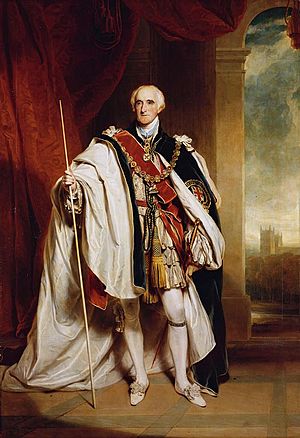
In 1821, he was appointed Lord Lieutenant of Ireland. Catholic emancipation had now become an open question in the cabinet, and Wellesley's acceptance of the viceroyalty was believed in Ireland to herald the immediate settlement of the Catholic claims but they would remain unfulfilled. Some efforts were made to placate Catholic opinion, notably the dismissal of the long-serving Attorney-General for Ireland, William Saurin, whose anti-Catholic views had made him bitterly unpopular. Lord Liverpool died without having grappled with the problem. His successor, Canning, died only a few months after taking up office as Prime Minister, to be succeeded briefly by Lord Goderich.
On the assumption of office by Wellington, his brother resigned the lord-lieutenancy. He is said to have been deeply hurt by his brother's failure to find a Cabinet position for him (Arthur made the usual excuse that one cannot give a Cabinet seat to everyone who wants one).
He had, however, the satisfaction of seeing the Catholic claims settled in the next year by the very statesmen who had declared against them. In 1833, he resumed the office of Lord Lieutenant under Earl Grey, but the ministry soon fell, and, with one short exception, Wellesley did not take any further part in official life.
Death
On his death, he had no successor in the marquessate, but the earldom of Mornington and minor honours devolved on his brother William, Lord Maryborough, on the failure of whose issue in 1863 they fell to the 2nd Duke of Wellington.
He and Arthur, after a long estrangement, had been once more on friendly terms for some years: Arthur wept at the funeral and said that he knew of no honour greater than being Lord Wellesley's brother.
Wellesley was buried in Eton College Chapel, at his old school. Wellesley's library was sold at auction in London by R. H. Evans on 17 January 1843 (and three following days); a copy of the catalogue, annotated with prices and buyers' names, is held at Cambridge University Library (shelfmark Munby.c.149(1)).
Legacy
The Township of Wellesley, in Ontario, Canada, was named in Richard Wellesley's honour, despite the many references (e.g.: Waterloo, Wellington County) to his brother, Arthur Wellesley in the surrounding area, as was Wellesley Island, located in the St. Lawrence river at Alexandria Bay. Wellesley Island also serves as the last point exiting the United States before crossing to Hill Island, in Canada.
Province Wellesley, in the state of Penang, Malaysia, was named after Richard Wellesley. It was originally part of the state of Kedah. It was ceded to the British East India Company by the Sultan of Kedah in 1798, and has been part of the settlement and state of Penang ever since. It was renamed Seberang Perai ("across the Perai" in the Malay language) not long after independence within Malaya.
The Wellesley Islands off the north coast of Queensland, Australia, were named by Matthew Flinders in honour of Richard Wellesley, as was the largest island in the group, Mornington Island. Flinders is believed to have done this during his imprisonment by the French on Mauritius Island as Wellesley had tried to secure his release.
Mornington Peninsula, south of Melbourne, was named after him.
As of the summer of 2007, a portrait of Marquess Wellesley hangs in the Throne Room at Buckingham Palace. A street in Mirzapur (United Provinces) was named Wellesleyganj
Arms


